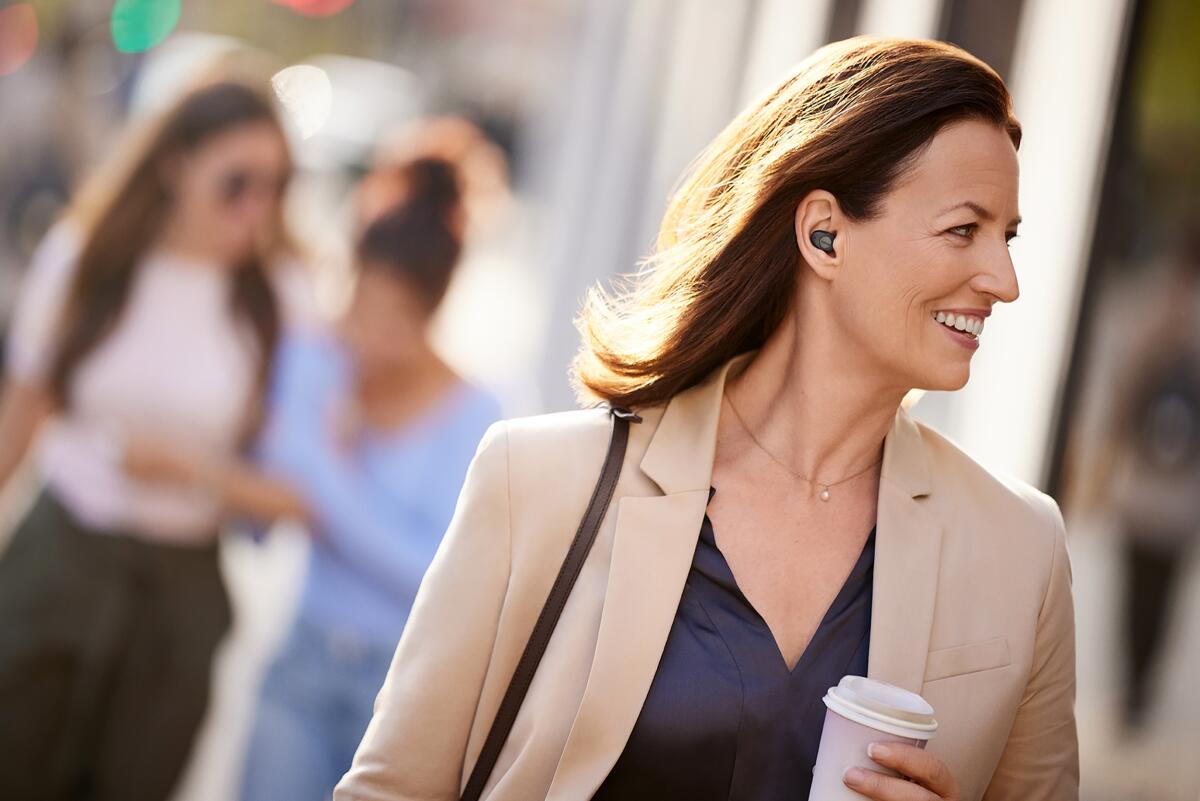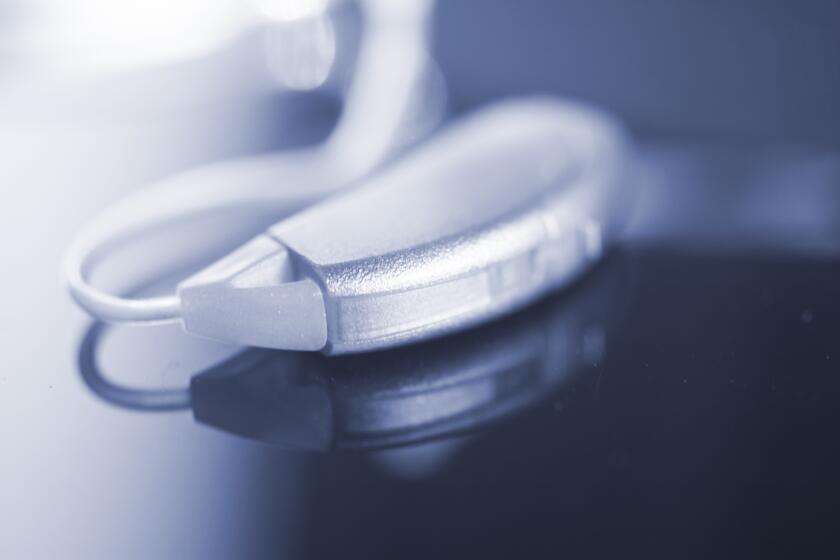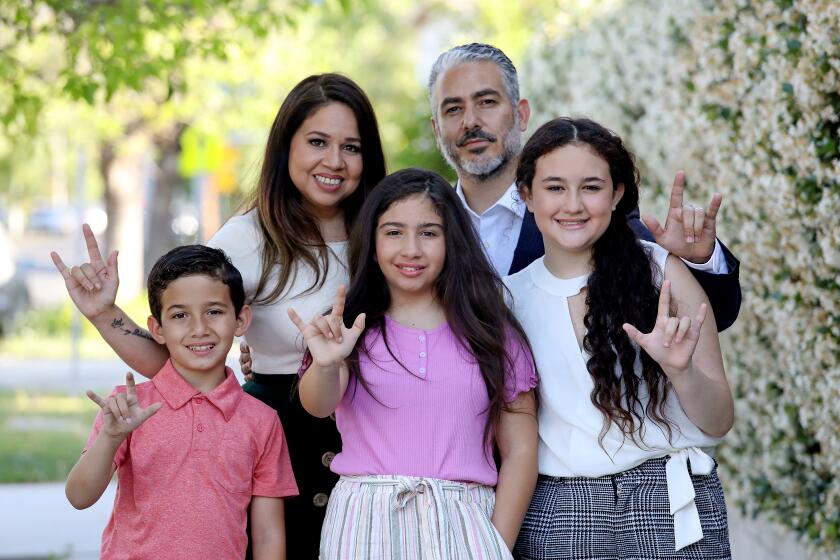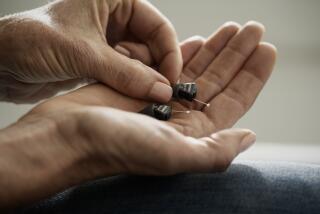The FDA says you can get hearing aids without a prescription. Here’s how

- Share via
Despite what Mick Jagger claims, time is not on our side.
Bodies degrade. Vision blurs. Memories dim. And conversations in a crowded restaurant or bar become well-nigh unintelligible.
“Everybody loses hearing as you get older. That’s just a fact of life,” said Dr. John Oghalai, an otolaryngologist with Keck Medicine of USC. It’s worse for some people than others, he added, noting that certain forms of hearing loss are hereditary.
The National Institute on Deafness and Other Communication Disorders estimates that 1 in 8 Americans age 12 or older — about 30 million people — has lost some hearing in both ears. But people who’ve been told they need hearing aids typically wait five to seven years to get them, said Barbara Kelley, executive director of the Hearing Loss Assn. of America.
One reason for the inaction, experts say, is the sky-high price. Going to a hearing professional (an otolaryngologist or audiologist) and being fitted for a hearing aid costs thousands of dollars, and insurance may not cover it. Medicare, for example, doesn’t pay for hearing aids or exams, although some Medicare Advantage plans might.
It may cost as little as $100 to manufacture a hearing aid. The list price is typically in the thousands of dollars (and not covered by most insurance).
To make hearing aids more affordable, the Food and Drug Administration finalized a rule this month that will make dozens of hearing aids available without a prescription. The move opens the door to widespread DIY treatment of mild to moderate hearing loss among adults. (If you’re under 18 or suffer from severe hearing loss, you’ll need to see a specialist.)
Be forewarned: Equipping yourself with a hearing aid isn’t as simple as buying reading glasses. It will require more tech savvy, more patience and — even in the new era of over-the-counter devices — more money. All the same, the cost will be far lower than it is today.
The over-the-counter market opens Oct. 17. The Times talked to medical experts, consumer advocates and industry insiders for tips on what to expect.
How do I know if I need a hearing aid?
Sound waves traveling through your ear canal cause your eardrum to vibrate. Those vibrations send signals through the tiny bones in your inner ear to the fluid-filled cochlea, where they’re transformed into electrical signals that stimulate your auditory nerves. A variety of factors — age, disease, injury, hygiene — can interfere with that signal chain, dimming or even obliterating sounds you once heard clearly.
Typical symptoms of mild to moderate hearing loss include having trouble hearing people on the phone, turning up the TV volume so much that other people complain, becoming tired from listening and hearing but not being able to understand conversations when there’s background noise. Often, Kelley said, your companions will notice your hearing issues before you do.
Oghalai said that if you don’t find yourself in many group settings — you don’t eat out often or don’t get called into many meetings — then you may not need hearing aids. Not everyone needs the same level of hearing functionality.
Further, some hearing problems aren’t the kind you can resolve with over-the-counter gadgets. The FDA says that if you can’t make out voices even when the room is quiet, or if you can’t hear loud music, power tools or other high-volume noises, your hearing loss is too severe for nonprescription devices to address.
Plus, the FDA says, some issues — including blood or fluid leaking from the ears, a sudden change in hearing, problems in one ear but not the other, vertigo or hearing loss that worsens and then gets better — are a sign of medical problems that need professional attention.
So how can you tell if your ears aren’t delivering the goods? An audiologist will typically put you in a soundproof booth, then determine how loud a sound has to be at a number of frequencies (that is, pitches) before you can detect it. That will produce a graph showing the frequencies in which you’ve suffered loss, as well as how significant the loss is.
As hearing aids move to over-the-counter sales, those tests will shift to the web and smartphone apps. You can see an example of a self-administered hearing test at Soundly.com, a Los Angeles-based site that sells hearing aids. The result is a graph showing how your left and right ear should detect sound at various frequencies and how well they actually do.
Be sure to take the test in a quiet room — the whoosh of air conditioning and the rumble of traffic could throw off your results.
Gigi Caruso, who was born with bilateral hearing loss, isn’t just a fashion designer or USC student. She’s helping those who can’t fully hear.
Everyone’s ears are unique, as are their hearing issues. But if you’re an older person experiencing presbycusis (age-related hearing loss), it’s probably increasing as the sound frequency rises, said Dr. Nina L. Shapiro, an otolayngologist at UCLA’s David Geffen School of Medicine.
Shapiro illustrated this point with a fun fact: “Older individuals tend to have a harder time hearing female voices, because they’re higher pitched.” (Insert your aging married couple joke here.)
I’ve tested my hearing. What else will I have to do?
The other main service you would get if you went to a hearing professional is a custom “fit.” That refers to how well the hearing aid matches your hearing loss, not to how good it feels in your ear (which we’ll get to in a minute).
Most hearing aids work by cranking the volume on the sounds reaching the eardrums. They have one or two miniature microphones and an amplifier that feed a tiny speaker wedged into your ear canal.
High-end hearing aids can be adjusted to provide more amplification in the specific frequency bands where you need it and less in the ones you don’t. The lower-end models aren’t as programmable; instead, they tend to offer a few optional settings to adapt the amplification to various environments, such as to help you understand speech in a noisy room.
The simpler devices “will be a fine solution for many people who don’t even know they have hearing loss,” Shapiro said.
Soundly Chief Executive Blake Cadwell predicts that most over-the-counter products will connect via Bluetooth to a smartphone app that will administer a hearing test, then customize the hearing aids to match hearing loss. Some apps will tune the hearing aids automatically in response to the test results; others will require the user to adjust settings in the app.
For example, if you buy the new Jabra Enhance Plus, the first thing you’ll do after putting them in your ears is connect them to the app and take a hearing test. The app will use those results to fit the hearing aids to your needs, while allowing you to switch to different presets according to social situation.
Taking the hearing specialist out of the equation is expected to cut more than half the cost of obtaining hearing aids, and it’s something consumers welcome, Cadwell said. According to a study by the consumer electronics company Bose, hearing aid customers “were happier with their outcomes when they were in control” of the settings, he said.
Unlike eyeglasses, however, hearing aids don’t make an immediate difference in your senses.
“Your brain has to get used to being able to hear again,” said Calum MacDougall, a marketing executive at Jabra. “It takes time and adaptation.”
In other words, it takes patience and, possibly, fine-tuning and adjustment.
L.A. Unified School District is poised to vote on a controversial proposal that may reshape education for thousands of deaf and hard-of-hearing students.
Hearing aids also need to physically fit well to be effective and comfortable. On that front, different styles present different challenges. Some models put most of the electronics behind the ear, then run a wire or tube to a receiver in the ear canal or fit it into the outer ear. Others sit visibly in the ear, like earbuds, and others are inserted completely into the ear canal.
Given these factors, Cadwell said, it’s important to recognize how much support consumers will require after they buy over-the-counter devices. When Soundly vets products, he said, it asks manufacturers whether they will have an audiologist on staff and a team of people ready to take customers’ calls.
MacDougall said Jabra — whose owner, the Danish company GN, also makes prescription hearing aids sold under the ReSound and Beltone brands — recognizes that over-the-counter devices will require a lot more customer support than the smartphone earbuds it sells. Among other things, the company plans to offer in-person help for Jabra Enhance Plus buyers at its Beltone stores, MacDougall said, adding, “We’re going to hold your hand much farther through the process.”
Who’ll make them, and where will I find them?
Hearing aid manufacturers are allowed to offer at least some of their previously prescription-only devices as over-the-counter products as soon as Oct. 17, and Cadwell predicts that a number of them will do so.
“I don’t know that we’re going to have any large, unexpected players who are not active in this space today,” he said.
The hearing aid market is dominated by five companies that sell products under dozens of names; aside from Jabra, none are familiar consumer brands. Consumers who are used to paying $100 to $200 for earbuds also won’t recognize the prices: A set of Lexie B1 hearing aids, which the FDA approved for over-the-counter sale, lists for $899.
Today, the products are sold mainly in places with hearing specialists, such as an audiologist’s office or Costco hearing center. But electronics superstore Best Buy has announced that it will carry over-the-counter hearing aids, and other big-box retailers and pharmacists are expected to follow suit.
One big question is whether Apple will jump in and disrupt the market the way it did with MP3 players and smartphones. It hasn’t announced a hearing aid, but it has added technology to its AirPods Pro line to help people with mild to moderate hearing loss.
While Apple’s products are designed first and foremost for phone calls and music, they are influencing the hearing aid market, MacDougall said. Apple not only popularized the earbud style, he said, but normalized the sight of people wearing earbuds all the time — even when interacting socially.
Is there a cheaper alternative?
In addition to prescription and over-the-counter hearing aids, there is a third type of hearing device, a personal sound amplification product. While it looks like a hearing aid, it sells for a much lower price — less than $50 in some cases.
Cadwell is not a fan.
“It amplifies sounds without taking into consideration your individual fingerprint of hearing loss,” he said.
The devices might come with a few presets to emphasize different frequency bands, he said, but otherwise they just make everything louder.
“You definitely can hear more, because the world just got turned up,” he said. But in busy environments, that can make the world more confusing.
Oghalai shared Cadwell’s concerns.
“These things are actually kind of dangerous,” he said, because they amplify everything and may not block sounds that are loud enough to cause damage.
What features should I look for?
Here are some things to consider when comparing the first crop of devices:
- Physical comfort. Does the device fit comfortably in your ear? How big is it, and how much does it weigh? Is it easy to remove and clean? If you plan to wear it all day, these considerations matter a lot more than if you’ll be using it intermittently.
- Battery life. This will also be a priority if you’ll be wearing it for long periods. The FDA requires that hearing aid packages indicate the type and number of batteries required, and whether the batteries are rechargeable. You’ll also want to know how long the device is expected to work on a single charge; products typically support at least one full day of use, Cadwell said, with rechargeable batteries becoming the norm.
- App features. Can the app program the hearing aids to automatically match your hearing loss? What sort of presets are available to adapt to different environments? Is the app available for your type of phone?
- After-sale support. Does the manufacturer offer the sort of expert guidance a hearing specialist would provide? How, where and for how long is the support available?
- Returns and exchanges. Kelley said you should check whether the manufacturer has a return policy and, if so, what it entails. You don’t want to buy a device that doesn’t meet your needs, then have no help from the manufacturer to figure out whether a different model or approach would do the trick.
- Connectivity. Some, but not all, hearing aids can connect to your phone and other Bluetooth-capable devices for calls and streaming audio. Also, some have telecoils that can connect directly to the audio feeds at theaters and other public spaces, blocking out background noise.
It’s important to remember that the market for these devices is in its infancy. Although millions of Americans might benefit from hearing aids, there’s no telling how many will buy over the counter. If the field draws in more consumer electronics companies, Kelley said, all sorts of innovation could ensue.
“Fifteen years ago, who would have thought that we could hold our computer, phone and TV in our hand?” she said. “That’s what this new market will allow for as well.”
About The Times Utility Journalism Team
This article is from The Times’ Utility Journalism Team. Our mission is to be essential to the lives of Southern Californians by publishing information that solves problems, answers questions and helps with decision making. We serve audiences in and around Los Angeles — including current Times subscribers and diverse communities that haven’t historically had their needs met by our coverage.
How can we be useful to you and your community? Email utility (at) latimes.com or one of our journalists: Jon Healey, Ada Tseng, Jessica Roy and Karen Garcia.










